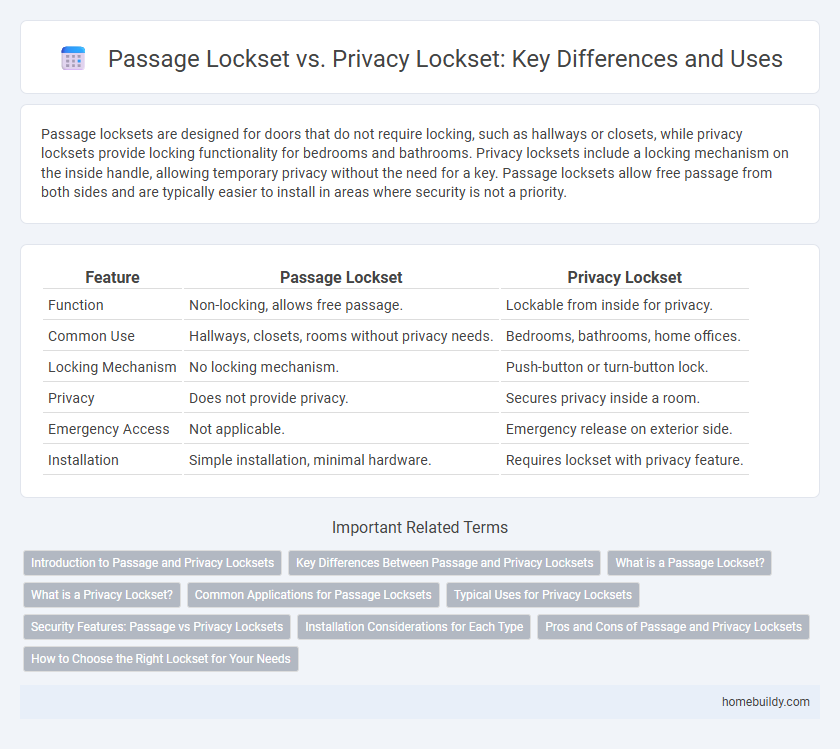Passage locksets are designed for doors that do not require locking, such as hallways or closets, while privacy locksets provide locking functionality for bedrooms and bathrooms. Privacy locksets include a locking mechanism on the inside handle, allowing temporary privacy without the need for a key. Passage locksets allow free passage from both sides and are typically easier to install in areas where security is not a priority.
Table of Comparison
| Feature | Passage Lockset | Privacy Lockset |
|---|---|---|
| Function | Non-locking, allows free passage. | Lockable from inside for privacy. |
| Common Use | Hallways, closets, rooms without privacy needs. | Bedrooms, bathrooms, home offices. |
| Locking Mechanism | No locking mechanism. | Push-button or turn-button lock. |
| Privacy | Does not provide privacy. | Secures privacy inside a room. |
| Emergency Access | Not applicable. | Emergency release on exterior side. |
| Installation | Simple installation, minimal hardware. | Requires lockset with privacy feature. |
Introduction to Passage and Privacy Locksets
Passage locksets provide easy access between rooms without locking mechanisms, making them ideal for hallways and closets where privacy is unnecessary. Privacy locksets feature a locking mechanism controlled from the interior, suitable for bedrooms and bathrooms requiring temporary privacy. Both locksets offer distinct functions to meet different security and accessibility needs within residential and commercial spaces.
Key Differences Between Passage and Privacy Locksets
Passage locksets do not have a locking mechanism and are primarily used for interior doors where privacy is not needed, such as hallways or closets. Privacy locksets include a locking feature activated by a thumb turn or push button on the inside, making them ideal for bedrooms and bathrooms where privacy is essential. The main key difference lies in the locking function, with passage locksets allowing free access and privacy locksets providing controlled access.
What is a Passage Lockset?
A Passage Lockset is a type of door hardware designed for interior doors where privacy is not required, such as hallways or closets, allowing free passage without locking capabilities. It features a latch mechanism that keeps the door closed but cannot be locked from either side, providing easy access and smooth operation. Passage Locksets are ideal for frequently accessed rooms, maintaining a clear pathway while ensuring the door stays securely closed.
What is a Privacy Lockset?
A Privacy Lockset is designed to provide security and privacy in bedrooms and bathrooms by allowing locking from the inside without a key, typically featuring a push-button or turn piece on the interior side. Unlike Passage Locksets, which do not lock and allow free access from both sides, Privacy Locksets ensure occupants can secure the door while maintaining easy emergency access via an exterior release mechanism. These locksets balance functionality and privacy, making them ideal for residential interior doors.
Common Applications for Passage Locksets
Passage locksets are commonly used on interior doors that do not require locking, such as hallway closets, pantry doors, and laundry rooms, providing easy access and passage. They are ideal for areas where privacy is not a concern but smooth operation and durability are essential. Unlike privacy locksets, passage locksets lack locking mechanisms and are optimized for frequent use in residential or commercial settings.
Typical Uses for Privacy Locksets
Privacy locksets are typically used in bedrooms and bathrooms where security and confidentiality are essential but emergency access is still required, as they feature a push-button or turn-style locking mechanism on the inside and an emergency release on the outside. These locksets provide a balance between privacy and safety, making them ideal for residential and hospitality applications. Unlike passage locksets, privacy locksets are designed to offer locking capabilities without the need for a key in daily use.
Security Features: Passage vs Privacy Locksets
Privacy locksets provide enhanced security features by incorporating a locking mechanism that allows users to secure doors from the inside, making them ideal for bedrooms and bathrooms. Passage locksets lack locking capabilities and are primarily used for interior doors where privacy and security are not a concern. The internal locking mechanism and keyed options in privacy locksets offer greater control over access compared to passage locksets, which only allow free passage between rooms.
Installation Considerations for Each Type
Passage locksets, designed for doors without locking functionality, require straightforward installation with basic alignment of the latch and handles, making them ideal for hallways or closets. Privacy locksets, equipped with a locking mechanism often activated by a thumb turn or push button, demand more precise installation to ensure proper function and security, particularly in bedrooms or bathrooms. Proper measurement of door thickness and mortise size is crucial for both types to guarantee compatibility and smooth operation.
Pros and Cons of Passage and Privacy Locksets
Passage locksets provide easy access without locking capabilities, ideal for hallways or closets, offering convenience and unimpeded movement but sacrificing privacy and security. Privacy locksets feature a locking mechanism suitable for bedrooms and bathrooms, enhancing security and personal privacy while sometimes complicating emergency access. Choosing between passage and privacy locksets depends on balancing ease of access against the need for security and confidentiality in various spaces.
How to Choose the Right Lockset for Your Needs
Choosing the right lockset depends on the intended function and privacy requirements of the space. Passage locksets are ideal for hallways and closets without locking needs, offering ease of access and convenience, while privacy locksets are designed for bedrooms and bathrooms, featuring a locking mechanism for occupant security without requiring a key. Evaluate the level of security needed, ease of use, and door type to select the appropriate lockset that meets both functional and privacy demands.
Passage Lockset vs Privacy Lockset Infographic

 homebuildy.com
homebuildy.com